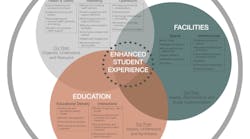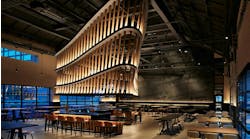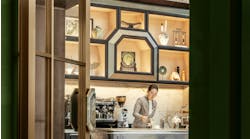The onset of COVID-19 left the country scrambling to make a quick transition to virtual working, learning and living. K-12 education faced a unique set of challenges, from technology and software, to student home-life challenges and stress.
As we moved forward planning to transition to the start of the new school year, districts have had a myriad of decisions to make, including health and safety, emotional health and wellbeing, and educational delivery.
What can we learn from the “during-pandemic” virtual learning state to inform the reopening of schools and, ultimately, the future of education? With the uncertainty of what’s to come, I believe it is important to evolve beyond reactive solutions to a reimagining of schools.
Based on a regenerative design philosophy combined with experience working closely with public school superintendents, the concept of reimagining schools has emerged. The hypothesis is as follows:
To reimagine schools in a way to provide barriers to the virus without creating barriers to learning and to use this disruption to initiate advancements that enhance student experience.
This hypothesis was derived through a journey with selected school district clients and their communities. The initial ideas in response to COVID-19, such as putting up partitions and physically separating students, were contrary to my approach as a designer of educational facilities. I couldn’t accept that as the answer. Those barriers, intended to keep people safe from the virus, seemed to have potential for extreme adverse effects for those very same people. Instead, I looked to a holistic response to COVID-19 in the hopes of offering something better.
Revaluating Prior to Reopening
To investigate this, we considered how schools looked previously and how teachers, students and their families were able to learn before and during the pandemic.
Before the pandemic, the concept of “school” was inseparable from educational facilities and traditional pedagogies. Challenging districts to articulate what “school” is, apart from the facilities and the physical classroom, helps to identify the culture of their district and what is innate in it and their community.
Also, while being thrown into the classroom-from-home model was not ideal, there are valuable takeaways from that experience. For instance, the online classroom and flexible hours allowed some
students and teachers to thrive. Others, however, struggled to keep up or stay engaged, and greater acknowledgment of the diversity of learning styles and aptitudes has emerged out of the pandemic.
Academic achievement assessment has also been forced to evolve, moving away from test taking to project-based learning and deliverables. The extensive gaps in equitable resources and learning opportunities has also been highlighted.
Once the academic calendar ended, districts quickly shifted to addressing how schools will operate in the fall. School districts either developed their own plan or adopted their state or county requirements. However, each school community is unique with its own set of conditions to resolve.
Preparing schools to reopen requires a delicate balance of instructional, facility and student/teacher mindfulness. How the reopening plan manifests in each district should be based on how these unique conditions are balanced.
[View our Reopening Schools eHandbook]
A New Framework for Schools
Working with districts to aid in their reopening plan, design strategists at Vaysen Studio developed a framework to organize each district’s reopening, taking into consideration facility capacity, student-teacher dynamics and the school’s culture.
The framework categorizes these considerations into: Essential Functions, Facilities, and Education (see accompanying illustration). While each consideration has its own challenges, they overlap and affect each other.
Surrounding these considerations are the vision and guiding principles of the district, and at their center is the drive of enhancing student experience. Holistically framing these considerations and overlaps is key to establishing the balance of instructional, facility and student/teacher mindfulness, and making decisions in service to the vision and guiding principles of the district.
Even as we try to navigate the “new norm” during this continued pandemic and into the future, schools are opening across the country. Initial school discussions around how to brings students back on campus safely focused on how to maintain social distance, wearing masks and handwashing, with a primary focus on the method of classroom engagement, and how to get students and teachers to and from school, as well as occupying the building safely.
In addition to these vital safety precautions, however, during my journey working with districts and listening to their challenges and heartaches, I kept going back to the second part of my hypothesis— Enhancing Student Experience. The framework we developed places this concept at its center. Regardless of the situation, this should always be a driver.
We realized with this once-in-a-lifetime disruption, something positive must emerge; something in service to the student experience. While many districts have begun moving towards 21st century learning styles and environments, this is often not consistent across a district and is certainly not consistent nationally.
Despite the data showing how these educational delivery models increase student success, advancement is slow and difficult, and the changes to foster those models is complex. Rethinking physical environments, educational methodologies, professional development and class scheduling is required to make that advancement—and here we are, in the middle of a global disruption that has the potential to drive that advancement.
Rather than exerting effort to make sure the pre-pandemic version of school is reinstituted, can districts evolve their approach to reimagine school? Through my investigations for reopening, it became clear there is immense potential in the experience, beyond just responding to COVID-19. The pandemic has demanded the utilization of technology in different ways, fostered self-guided learning paths and project-based learning, brought disparities in student needs to light, and highlighted the importance of social and cognitive engagement. New educational models must respond to these aspects. They can result in classroom environments that, by their nature, are designed for varied sizes of student groups and individual learners.
Applying This New Framework
For one district, the vision and guiding principles of school, beyond learning academic content, emerged to be: Fostering connections and relationships; providing equitable opportunities; flexibility (of learning and teaching strategies); and a system of structure and accountability. These drivers are adeptly realized in a 21st century learning model. The district came to acknowledge a rigid return to traditional learning environments might actually hinder these goals.
I urge designers to work with school districts in this holistic manner, to find the opportunities for greater educational improvements, and to use the disruption of COVID-19 to move education forward and enhance student experience. The educators I have been working with are thirsty for this approach, for more big-picture and aspirational thinking.
Moving forward, Vaysen Studio will continue working with our school districts to mark the opportunities as we uncover them and evolve towards a more dynamic educational experience, testing our hypothesis. From this great disruption, we can find great potential—you just have to know to look, listen, engage and synthesize. For more information, visit www.vaysen.com.
Read Next: Evidence-Based Design Helps Designers Reach the Best Future Reality Post COVID-19
About the Author
Susanne Angarano is a principal at Vaysen Studio. Her extensive experience includes a focus on higher education projects and holistic sustainable design work. Committed to environmentally sound design, she works to achieve design excellence through a process of stakeholder engagement to create spaces that connect with culture and context. AngaranoSusanne is the recipient of the 2019 ASID Ones to Watch award, and her interior design work on MacArthur Elementary school was awarded the 2019 ASID Design Impacts Lives honorable mention.


